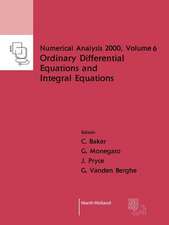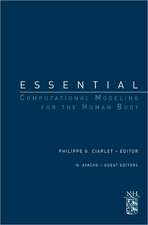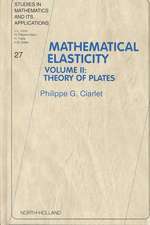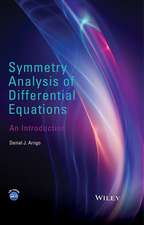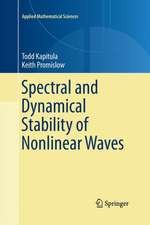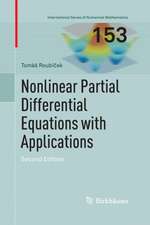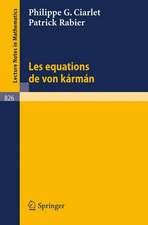Three-Dimensional Elasticity: Studies in Mathematics and its Applications, cartea 20
Philippe G. Ciarleten Limba Engleză Paperback – 18 ian 1994
Preț: 336.16 lei
Nou
Puncte Express: 504
Preț estimativ în valută:
64.33€ • 67.38$ • 53.31£
64.33€ • 67.38$ • 53.31£
Carte tipărită la comandă
Livrare economică 02-16 aprilie
Preluare comenzi: 021 569.72.76
Specificații
ISBN-13: 9780444817761
ISBN-10: 044481776X
Pagini: 456
Dimensiuni: 156 x 234 x 30 mm
Greutate: 0.83 kg
Editura: ELSEVIER SCIENCE
Seria Studies in Mathematics and its Applications
ISBN-10: 044481776X
Pagini: 456
Dimensiuni: 156 x 234 x 30 mm
Greutate: 0.83 kg
Editura: ELSEVIER SCIENCE
Seria Studies in Mathematics and its Applications
Cuprins
Part A. Description of Three-Dimensional Elasticity 1. Geometrical and other preliminaries. 2. The equations of equilibrium and the principle of virtual work. 3. Elastic materials and their constitutive equations. 4. Hyperelasticity. 5. The boundary value problems of three-dimensional elasticity. Part B. Mathematical Methods in Three-Dimensional Elasticity 6. Existence theory based on the implicit function theorem. 7. Existence theory based on the minimization of the Energy. Bibliography. Index.
Recenzii
C.O. Horgan
"The book certainly earns its place in the annals of distinguished contributions to elasticity theory. One is led to anticipate eagerly the appearance of Volume 2." --Mathematical Reviews
J. Francu
"The book is written in the elegant, bright style of an experienced pedagogue. The well thought out notation is unified throughout the whole volume. Besides specific concepts of elasticity, all nontrivial auxiliary topics of functional analysis and other branches of mathematics are explained and illustrated by examples. The chapters are concluded by exercises. The book is also ideal from a formal point of view, using various typefaces for emphasis and framing important formulas and figures. The volume is equipped with a 20-page survey of the main notation, definitions and formulas, a 573-item bibliography, and a 17-page index. This nice book can be fully recommended as an introductory textbook to contemporary nonlinear elasticity as well as a working textbook at graduate level for courses in pure or applied mathematics or in continuum mechanics." --Acta Applicandae Mathematicae
J. Blume
"Mathematical Elasticity is strongly recommended to those with some background in elasticity who would like to understand the most mathematical aspects of nonlinear elasticity theory. The book will serve as an excellent reference." --Applied Mechanics Reviews
G.P. MacSithigh
"...covers a great deal of material without ever seeming cramped or cluttered... on each topic he proceeds briskly to the heart of the matter... a stimulating way to learn a subject... I come away from the book with a much-enhanced appreciation of several topics I thought I already knew... a superb textbook..." --SIAM Review
R.J. Knops
"The author states that his aims are to convince "the application-minded readers that analysis is indispensable for a genuine understanding of elasticity,... especially in view of the increasing emphasis on nonlinearities" and, on the other hand, to convince "the more mathematically oriented readers that elasticity, far from being a dusty classical field, is on the contrary a prodigious source of challenging open problems". These aims are abundantly fulfilled, and the enriching interlacing of mathematics with sound physical insight firmly places the book in the tradition of those who in the postwar period set about the task of revitalising and rigorously restructuring continuum mechanics. The book, a masterly account of the subject, deserves the widest readership. The second volume is awaited with equal enthusiasm." --Bulletin (New Series) of the American Mathematical Society
"The book certainly earns its place in the annals of distinguished contributions to elasticity theory. One is led to anticipate eagerly the appearance of Volume 2." --Mathematical Reviews
J. Francu
"The book is written in the elegant, bright style of an experienced pedagogue. The well thought out notation is unified throughout the whole volume. Besides specific concepts of elasticity, all nontrivial auxiliary topics of functional analysis and other branches of mathematics are explained and illustrated by examples. The chapters are concluded by exercises. The book is also ideal from a formal point of view, using various typefaces for emphasis and framing important formulas and figures. The volume is equipped with a 20-page survey of the main notation, definitions and formulas, a 573-item bibliography, and a 17-page index. This nice book can be fully recommended as an introductory textbook to contemporary nonlinear elasticity as well as a working textbook at graduate level for courses in pure or applied mathematics or in continuum mechanics." --Acta Applicandae Mathematicae
J. Blume
"Mathematical Elasticity is strongly recommended to those with some background in elasticity who would like to understand the most mathematical aspects of nonlinear elasticity theory. The book will serve as an excellent reference." --Applied Mechanics Reviews
G.P. MacSithigh
"...covers a great deal of material without ever seeming cramped or cluttered... on each topic he proceeds briskly to the heart of the matter... a stimulating way to learn a subject... I come away from the book with a much-enhanced appreciation of several topics I thought I already knew... a superb textbook..." --SIAM Review
R.J. Knops
"The author states that his aims are to convince "the application-minded readers that analysis is indispensable for a genuine understanding of elasticity,... especially in view of the increasing emphasis on nonlinearities" and, on the other hand, to convince "the more mathematically oriented readers that elasticity, far from being a dusty classical field, is on the contrary a prodigious source of challenging open problems". These aims are abundantly fulfilled, and the enriching interlacing of mathematics with sound physical insight firmly places the book in the tradition of those who in the postwar period set about the task of revitalising and rigorously restructuring continuum mechanics. The book, a masterly account of the subject, deserves the widest readership. The second volume is awaited with equal enthusiasm." --Bulletin (New Series) of the American Mathematical Society







